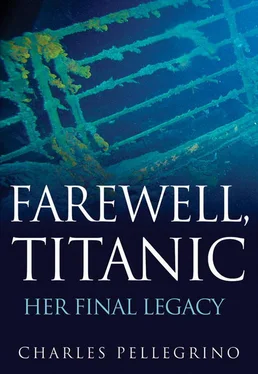Tonight, Sunday night, the places where the steel had glowed red were horribly apparent: in order for steel half an inch thick to emit a noticeably red glow, the bottom of the bulkhead must have reached a minimum temperature of 1,300 degrees Fahrenheit, shifting the iron crystals into a harder and less flexible alignment. The loss of flexibility should not have mattered very much as long as the bulkhead—its base dented and warped out of shape—was not called upon to do any great deal of extra work before it could be repaired in New York.
Barrett was located in a boiler room just forward of the fire damage when stoker George Beauchamp, standing nearby, saw the telegraph from the engineer’s platform in the reciprocating engine room signaling with a red stop light. Very soon after the signal came a rumble from the starboard hull “like the roar of thunder,” in Beauchamp’s words.
“Shut the dampers!” Barrett hollered—an order that was shorthand for “cut off the air supply to the furnaces.” The order had not yet been carried out, and other men were still relaying the message, when water began spraying into the compartment two feet above the floor plates. It seemed to Barrett that the lower margin of the ship’s starboard side had suddenly developed a series of rents and at least one hole.
In the next compartment aft, boiler room number 5, John Shepherd, an engineer, watched a hole open up about two feet behind the fire-damaged bulkhead; this meant that the bulkhead itself (already rendered brittle at its base) had suffered a lateral, compressive kick from the iceberg. In spite of this, the men with Shepherd were not worried. The hole was small, no wider than the bottom of a beer bottle, and it appeared to be the damage farthest to the rear.
Boiler room number 5’s pumps should surely have been able to handle it, from everything Shepherd, Barrett, and Beauchamp knew. The giant on the other side of the hull seemed to be losing strength as it pounded toward the rear along boiler room number 5. It had failed even to disturb the piles of coal in the boiler room’s hind bunker. With the danger passing—and evidently weakening—the worst they expected was a detour to Belfast, Ireland, for repairs. The three of them knew that the ship would stand up well against any possible assault. The new science of compartmentalization was bound to keep them perfectly safe. In little more than an hour, only two of them would still be alive.
• • •
Directly above the ceilings of the foremost boiler rooms and the coal bunker fire, Norman and Bertha Chambers and their neighbors in first class noticed that their staterooms had remained unbearably hot throughout the voyage. Even after the bunker fire was extinguished, the heating problem persisted, so the Chamberses went to sleep that night with the porthole of their stateroom, E-7, wide open. At 11:40 they were awakened by ice rumbling through the opening and onto the bedroom floor. In E-25, a few staterooms back at the end of the hallway, James McGough was also awakened by chunks of ice falling through his open porthole.
• • •
About ninety feet away from E-7 and E-25, on the port side of the first smokestack, seventeen-year-old Jack Thayer had also tried to combat an inexplicable overheating of his room by leaving his porthole open. Because he was opposite the iceberg’s impact along the starboard side, as well as two decks higher than the Chamberses, Thayer’s perception of the collision was less dramatic. He merely felt the floor sway, as though the ship were being gently pushed from the starboard side in a new direction.
Some ninety feet behind Barrett and the dam at the front of boiler room number 5, the same shock of impact—which seemed to have been abating as it punched only one tiny hole in the boiler room and gently swayed the deck beneath Thayer’s feet—came on again stronger when it roared through boiler room number 4. All of the lights in the compartment went out, and coal trimmer George Cavell thought that the impact would have knocked him completely off his feet had an avalanche of coal not buried him first. The earliest, ominous sounds of gurgling must also have started about the same moment, but Cavell was too busy rescuing himself from premature burial to take notice.
Minutes later, when boiler room number 4’s electrician restored the lights, Cavell would begin to wonder if his escape from suffocation was only a brief respite. Water began rising steadily through spaces in the floor plates—rising definitely from somewhere below. Although boiler room number 4’s bilge pumps would presumably be able to keep the sea from rising up to Cavell’s waist, it was clear that the mischief being worked between the iron and the ice did not stop at the border between boiler rooms number 5 and 6.
Boulders of ice breaking away and bouncing along the ship’s bottom had evidently begun inflicting damage along the Titanic’ s double-hulled keel as well as along the ribbing and surface of the starboard side. The ice fall added up to a significant loss of weight along the iceberg’s Titanic -facing side, and if at the moment of impact the ship was also riding over a submerged ledge of ice as well as abrading the berg’s side, this same weight loss could have caused the ledge to rise slightly by the time it reached boiler room 4.
• • •
Under the ship’s third smokestack, nearly 150 feet behind Cavell in boiler room number 4, fireman George Kemish had just checked the dials in boiler room number 2 when the crash came. The ship was running with a full head of steam—then accelerating gradually to twenty-three knots. Everything seemed to be working to perfection, until the telegraph signaled stop , and there followed “a heavy thud and grinding tearing sound,” according to Kemish.
More than a hundred feet behind Kemish’s compartment, among the steam engines between the third and fourth smokestacks, coal trimmer Thomas Patrick Dillon felt more than heard the impact. It came to him as “a slight shock,” following the ringing of the alarm from the bridge by between two and “a few” full seconds. There was a lag time between the stop alarm from the bridge—the shouting out of the stop order to the men running the engines—and the relaying of a signal to stop feeding the boilers and to shut the dampers, which were 250 feet forward from Kemish’s position, in Barrett’s boiler room.
During this interval, the iceberg continued moving toward Dillon at approximately forty feet per second. The “slight shock” Dillon felt was merely the last note in a resounding chorus of ice chunks falling against the starboard hull. Near the ship’s stern the impact felt so slight that virtually no one took it to mean anything serious.
• • •
For thirteen-year-old second-class passenger Madeline Mellinger, much in her life had already gone seriously wrong. She missed her father dearly, and her mother never spoke about the exact nature of the “mistake” he had made that ultimately drove him out of England. His last beautiful letter to Madeline had come from Christchurch, New Zealand, in 1909—and then there was only a desert of silence.
Madeline’s father had been a journalist—“a genius whose extravagant high living brought the family to ruin,” Madeline recalled. She remembered cheerless and cold-sounding words from early childhood, such as divorce and auction sale , followed by the loss of her family’s home furnishings, all of the fine family heirlooms, and finally her home itself.
Madeline’s mother, Elizabeth, had become a maid and traveling companion for wealthy families. She was eventually forced to send Madeline away to relatives and then to a girls’ boarding school outside London. Now, at last, the sequence of disasters seemed to be abating. The year 1912 had become one of promise and adventure, once Elizabeth secured a permanent job with relatives of the Colgates, a family known, in those days, as “new money”—still in the process of making its fortune by turning powdery mixtures of chalk microfossils and peppermint oil into toothpaste.
Читать дальше











